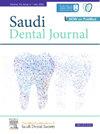Differences in linear and angular measurement of the lower facial third in lateral cephalometry and lateral photometry: A comparative study
IF 2.3
Q3 DENTISTRY, ORAL SURGERY & MEDICINE
引用次数: 0
Abstract
Background
In clinical orthodontic practice, to evaluate aesthetics in dentistry, lateral cephalometry and lateral photometry are used to measure and assess craniofacial morphology. In contrast to cephalometry, photometry has no radiation hazard and is less expensive. There has been a paradigm shift in contemporary orthodontics that now emphasizes soft tissue aesthetics, rather than depending entirely on hard tissue evaluation from lateral cephalometry. Therefore, the key question is whether lateral photometry can be a substitute for conventional cephalometry for diagnostics, prognostic analysis, and treatment planning.
Objective
To differentiate between lateral cephalometry and lateral photometry measurement in children with stage 2 and 3 vertebrae maturation in the Deutero Malay population.
Materials and Methods
A standardized protocol was followed for all lateral cephalograms and photographs from 38 subjects who met the inclusion criteria. Three parameters focusing on the lower third craniofacial measurement were investigated: two linear parameters (mandibular ramus length and mandibular length) and one angular parameter (gonial angle). These parameters were measured using Webceph software. All parameters were digitized on both cephalograms and photographs and were compared using an independent sample t-test.
Results
When comparing the angular cephalometric and photometric variables, we found that the mandible length (Go-Me) and gonial angle (∠Go) in the cephalometry measurements had an insignificant difference compared to the photometric measurements, while the ramus length (Co-Go) in the cephalometry measurement had a significant difference compared to the photometric measurements.
Conclusion
Although we cannot rule out cephalometry as the primary record in orthodontics, lateral photometry assessment can be used as an alternative candidate for measuring mandibular body measurements and gonial angle in stage 2 and 3 cervical maturation in the Deutero Malay race.
侧面头颅测量法和侧面光度测量法在面部下三分之一处的线性和角度测量中的差异:比较研究
背景在临床正畸实践中,为了评估牙科美学,侧方头颅测量法和侧方光度测量法被用来测量和评估颅面形态。与头颅测量法相比,光度测量法没有辐射危害,而且成本较低。当代正畸学的模式已经发生了转变,现在强调的是软组织美学,而不是完全依赖于侧向头颅测量法对硬组织的评估。因此,问题的关键在于侧位光度法是否可以替代传统的头颅测量法,用于诊断、预后分析和治疗计划。 Objective To differentiate between lateral cephalometry and lateral photometry measurement in children with stage 2 and 3 vertebrahature maturation in the Deutero Malay population.Materials and Methods 对符合纳入标准的 38 名受试者的所有侧位头颅影像和照片均按照标准化方案进行测量。研究重点是下第三颅面测量的三个参数:两个线性参数(下颌嵴长和下颌长)和一个角度参数(盂角)。这些参数使用 Webceph 软件进行测量。结果在比较头颅测量和光度测量的角度变量时,我们发现头颅测量中的下颌长度(Go-Me)和盂角(∠Go)与光度测量相比差异不明显,而头颅测量中的颌骨长度(Co-Go)与光度测量相比差异明显。结论虽然我们不能排除将头颅测量作为正畸的主要记录,但侧向光度评估可作为替代方法,用于测量德特罗马来人第二和第三阶段颈椎成熟期的下颌骨体测量和盂角。
本文章由计算机程序翻译,如有差异,请以英文原文为准。
求助全文
约1分钟内获得全文
求助全文
来源期刊

Saudi Dental Journal
DENTISTRY, ORAL SURGERY & MEDICINE-
CiteScore
3.60
自引率
0.00%
发文量
86
审稿时长
22 weeks
期刊介绍:
Saudi Dental Journal is an English language, peer-reviewed scholarly publication in the area of dentistry. Saudi Dental Journal publishes original research and reviews on, but not limited to: • dental disease • clinical trials • dental equipment • new and experimental techniques • epidemiology and oral health • restorative dentistry • periodontology • endodontology • prosthodontics • paediatric dentistry • orthodontics and dental education Saudi Dental Journal is the official publication of the Saudi Dental Society and is published by King Saud University in collaboration with Elsevier and is edited by an international group of eminent researchers.
 求助内容:
求助内容: 应助结果提醒方式:
应助结果提醒方式:


